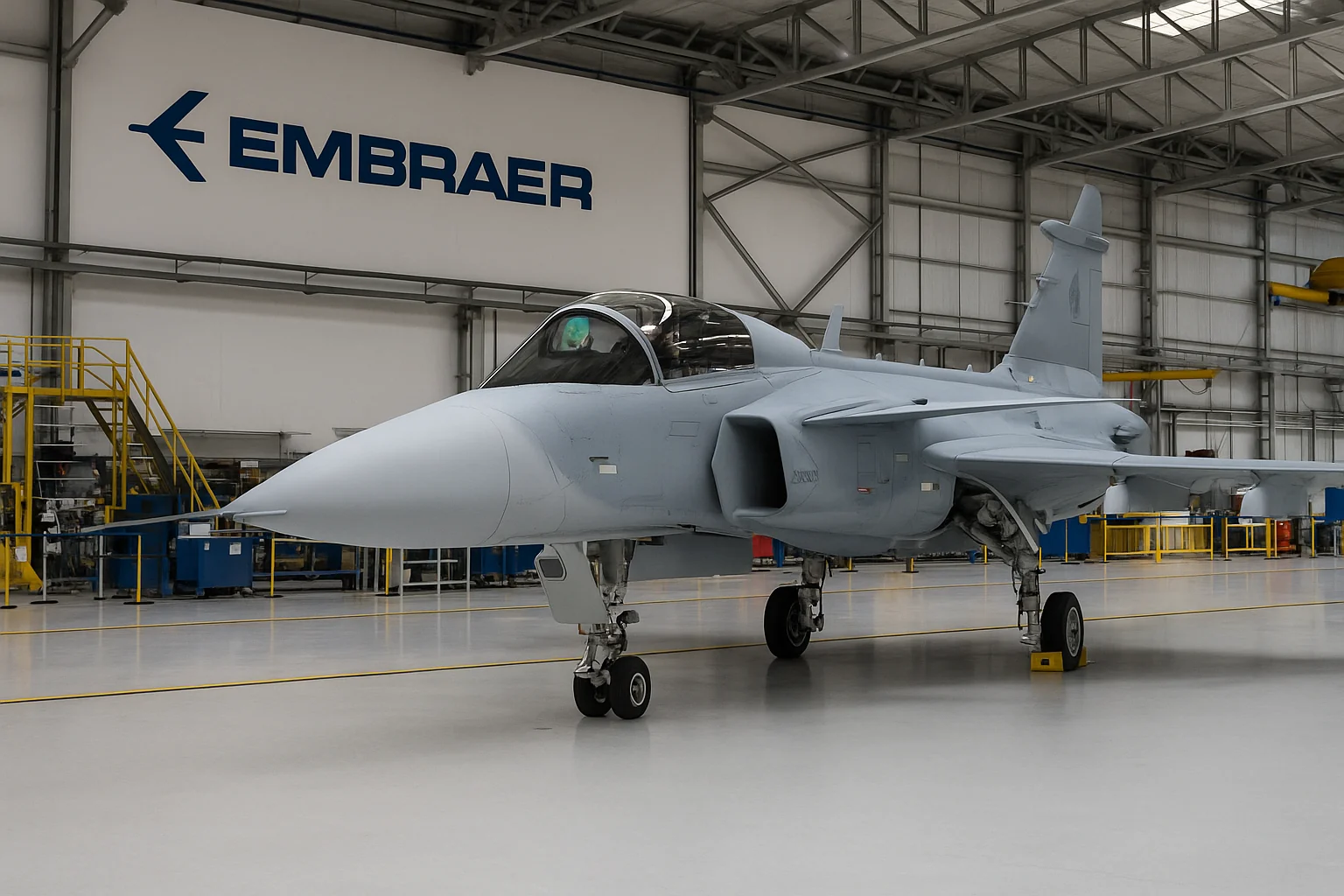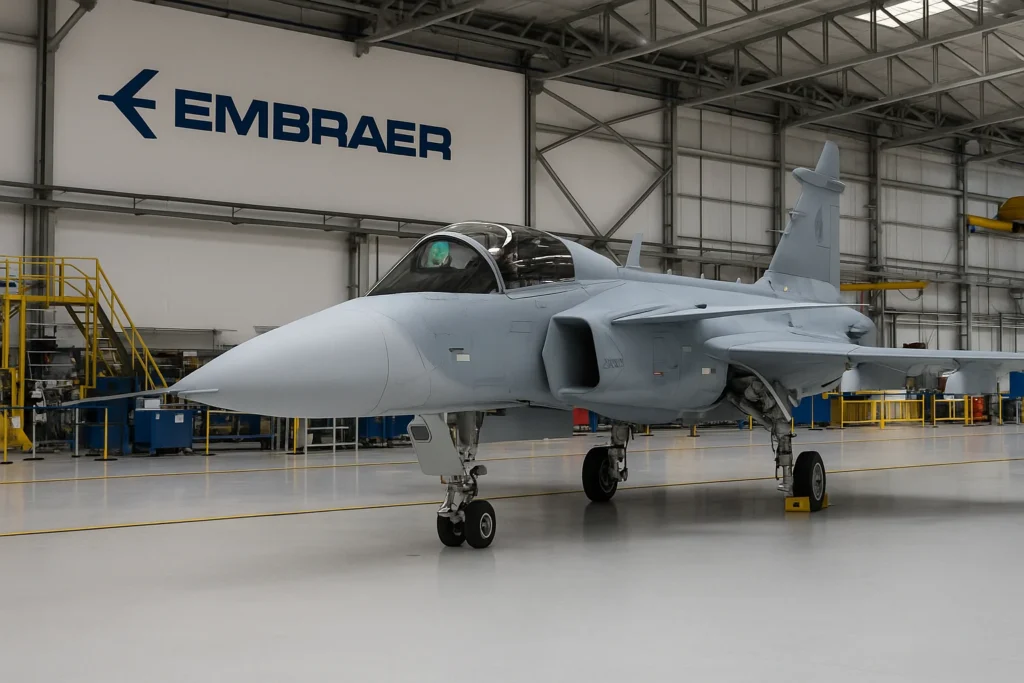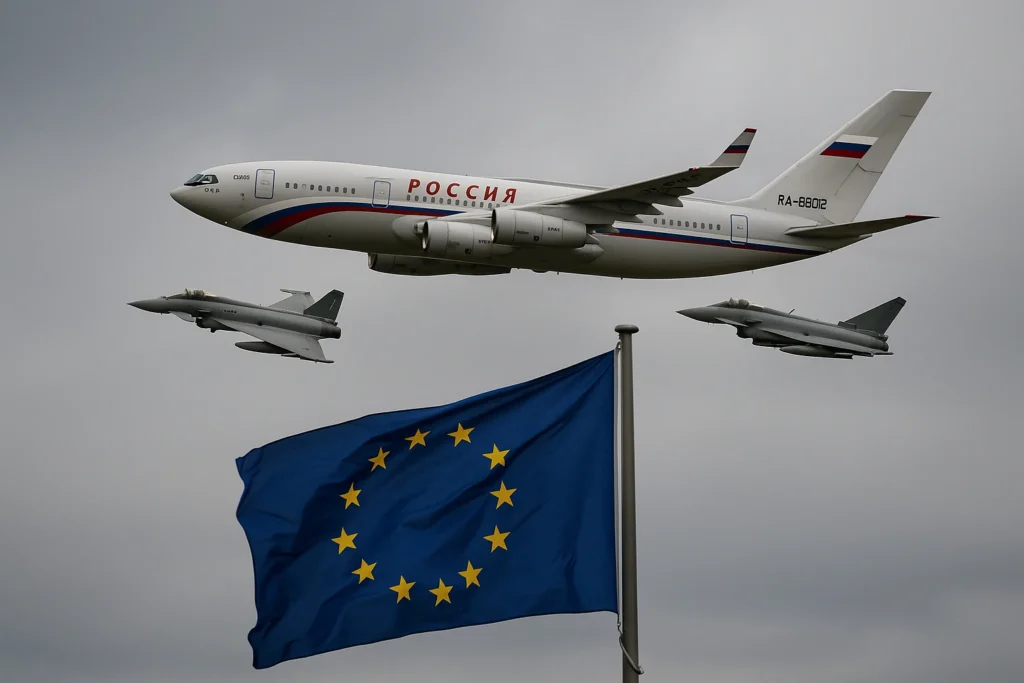When Brazil signed its $5.4 billion contract for 36 Saab Gripen fighter jets in 2014, the deal was hailed as a landmark in the nation’s defense modernization. Eleven years later, the promise of cutting-edge air power has turned into a chronicle of delay, inflation, and bureaucratic fatigue. What was supposed to be a swift technology transfer and industrial leap for Brazil’s aerospace sector has become a lesson in how ambitious defense projects falter when politics, production limits, and corporate caution collide.
At the Embraer plant in São Paulo, the first Gripen fully assembled in Brazil is finally nearing completion. The Brazilian Air Force plans to take delivery in November 2025. Air Force Commander Marcelo Kanitz Damasceno confirmed the schedule, calling the milestone a “symbol of national capability.” Yet the symbolism masks the uncomfortable truth: the project has slipped nearly eight years behind schedule, and the program’s costs continue to climb.
The 2014 contract envisioned 36 aircraft — 28 single-seat JAS 39E models and eight dual-seat JAS 39F variants — with 15 to be produced in Brazil. It was meant to transform Embraer from a regional-jet manufacturer into a global defense player. Instead, after more than a decade, the first truly Brazilian-assembled Gripen is only now emerging from the hangar. The country expected to complete deliveries by early 2025. They are now projected to continue until 2032.
A Contract Stuck in the Past
The Gripen deal was originally sold as a partnership of equals. Sweden would provide the technology, Brazil the industrial capacity. In reality, the transfer of know-how has been slower than promised. Saab, still facing its own production bottlenecks, has delivered only ten aircraft from Sweden. Two of those are still undergoing testing, leaving just nine operational fighters assigned to Brazil’s 1st Air Defense Group.
For a nation that wanted to strengthen sovereignty and domestic manufacturing, the timeline reads like a failure of ambition. It took Brazil eleven years to localize assembly — and even then, the work remains partial, more “integration” than true production. Officials in Brasília frame the program as a long-term investment, but the Air Force’s own leadership admits the delays are serious.
Air Force Chief of Staff Brigadier General Walcyr Josué de Castilho Araújo has acknowledged “problems with the production and rising cost” of the Gripen program. According to Infodefensa, the total price tag has risen by 13 percent — a significant overrun that, at today’s rate, could buy six additional fighters.
The Price of Strategic Patience
Brazil’s government insists the partnership remains worthwhile. The technology exchange, they argue, is priceless: Brazilian engineers are working side-by-side with Swedish counterparts, learning advanced avionics and systems integration. Yet such optimism hides the strain of financing a project that has delivered fewer planes than expected, at a slower pace, and for more money.
In 2025, Brazil expects to receive only two aircraft. The delivery calendar stretches thinly across the next decade: one jet in 2026, four in 2027, five in 2028, two in 2029, three in 2030, and five each in 2031 and 2032. For a program that was supposed to re-equip the Air Force swiftly, this schedule borders on absurd.
The Brazilian Gripen’s sluggish progress contrasts sharply with the rapid-fire procurement cycles of other countries modernizing their air forces. In Asia and the Middle East, similar fifth-generation programs are advancing faster and at lower relative cost. Brazil’s defense planners, in contrast, are trapped in the middle ground between self-reliance and dependency — too proud to cancel, too committed to quit.
Saab’s Own Troubles
The delays are not only Brazil’s fault. Saab faces rising demand and supply-chain bottlenecks across Europe as nations scramble to rearm in the shadow of Russia’s war in Ukraine. Components for Gripen fighters, from radar systems to composite wings, are stretched thin across production lines. For the Swedish manufacturer, Brazil’s order — once a prestige export — now competes with urgent orders from NATO countries.
Moreover, Saab’s cautious corporate culture and strict control over intellectual property have limited how much real manufacturing has migrated to South America. Embraer technicians may assemble parts, but core systems still arrive from Sweden in sealed crates. For all the rhetoric about sovereignty, Brazil remains dependent on Scandinavian supply chains and approval.
Industrial Dreams and Political Reality
The Gripen deal was supposed to crown Brazil’s ambition to become a defense technology hub for the Global South. It was also a geopolitical statement: Brazil chose Sweden’s jet over American and French offers, signaling independence from traditional Western suppliers. Eleven years later, that independence looks hollow. The country’s defense policy has shifted under successive presidents, and funding fluctuations have slowed every stage of production.
Embraer’s engineers speak of progress, but local unions whisper frustration. A generation of Brazilian technicians trained for the program now see their careers stalled by bureaucratic pauses and changing political priorities. When the first jet finally takes flight from domestic soil later this year, it will represent endurance more than triumph.
A Warning for Emerging Powers
Brazil’s experience illustrates the hidden cost of “nationalizing” advanced technology under globalized defense contracts. Political leaders promise jobs, technology transfer, and strategic autonomy. In practice, they inherit dependency, delay, and budget strain. The Gripen partnership gave Brazil prestige on paper — but eleven years later, its air force still relies on imported systems to protect a continent-sized nation.
The 13 percent cost increase may seem modest in isolation, but in Brazil’s constrained defense budget it diverts funds from other urgent needs, including modernization of naval and transport fleets. Inflation in global defense markets and a weaker real exacerbate the problem.
Still, canceling the program is unthinkable. Too much has been invested, both politically and industrially. Embraer’s reputation as a defense partner depends on completing it. Saab, too, cannot afford a public failure that would haunt future export negotiations.
Delayed Deterrence
Strategically, the eight-year delay matters. South America remains one of the world’s least militarized regions, but regional balance is fragile. While neighboring Chile and Colombia have upgraded fleets, Brazil — the region’s largest economy — flies fewer than a dozen operational new-generation fighters. That gap reduces deterrence and limits Brazil’s ability to project power or respond to crises.
For a country seeking a permanent seat on the UN Security Council, the optics are awkward. How can a nation argue for global leadership when its flagship defense project moves at half speed?
The Mirage of Self-Reliance
Brazil’s story echoes similar failures across the developing world, where political ambitions outpace industrial capacity. Countries dream of independence through domestic production, yet real autonomy demands decades of consistent investment and stable policy. The Gripen project became a mirror of Brazil’s contradictions: a rising power with world-class engineers but inconsistent leadership and volatile budgets.
In São Paulo, the new Gripen gleams under factory lights — a technological marvel born of persistence and compromise. But the longer the project drags on, the more it resembles a warning rather than a victory.
External Links
- Reuters – Brazil’s Gripen fighter jet program delayed, cost rises
- Defensa – Brazil confirms schedule changes for Gripen production
78 views






